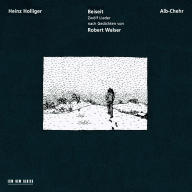Holliger was born on May 21, 1939, in Langenthal, Switzerland, near Bern. He began playing the recorder at age four and piano at six. At 11, he switched to oboe, studying with Emile Cassagnaud and Sándor Veress at the Bern Conservatory. He then moved to Paris to study oboe with Pierre Pierlot and piano with Yvonne Lefébure. In 1959, he won first prize for oboe in the Geneva Competition, and in the same year, he was hired as an oboist by the Basel Symphony Orchestra. Holliger began composing when he was young and has compiled an extensive catalog in many genres. He studied composition in Paris from 1961 to 1963 with Pierre Boulez, who became a key influence on his style. His music is thoroughly influenced by Schoenberg, Webern, and Luigi Nono. The Magical Dances for two dancers, chorus, orchestra, and tape, is a work of exceptional aural density and fine nuances. Holliger's career as an international oboe virtuoso began in 1963. His tours included solo appearances, performances with his late wife, harpist Ursula Holliger, and chamber music appearances with the Holliger Ensemble, a chamber group he founded.
Holliger was appointed professor of oboe at the Staatliche Musikhochschule of Freiburg in 1965. He quickly became known as the most outstanding oboist of the time, adopting the smoother, thinner French (although exceptionally bright) sound rather than the wider German quality. In interviews, he has disputed the accreditation for extending the oboe's technical range, saying, "I have invented nothing"; he points to instances where these techniques appeared in earlier music, such as a glissando in Mahler's Third Symphony, but in fact, he was the first to make extensive use of these techniques. In addition, he has introduced new sounds attainable only by placing a microphone inside the instrument. He has been very alert to the need for expanding the repertoire of the instrument, being critical of oboists for not commissioning challenging new works. Holliger has personally commissioned works from Berio, Stockhausen, and Penderecki, among others. The Double Concerto for oboe, harp, and chamber orchestra by Lutoslawski, written for Holliger and his wife, is considered a masterpiece of 20th century literature. Holliger's music has a very tight, internal logic caused by the strict use of serial procedures. His musical textures can range from slow, attenuated wisps of sound to combinations of instrumental sound so thick that they practically become "white noise." His compositions are almost uniformly technically difficult to perform and highly challenging for the listener. Pneuma (1970) for 36 winds, four radios, organ, and percussion, requires the performers to make specific breathing sounds into microphones; Cardiophonie (1971) uses an amplified stethoscope attached to a solo wind player to add the players' pulse to the music.
Holliger's extensive recording history has seen him featured on dozens of releases on labels including Decca, Philips, and Sony Classical, among many others. These recordings include performances of his own compositions, winning a Grammy award for his opera Schneewittchen (2000) on the ECM label; his many recordings on oboe range from classical giants, such as Bach and Mozart, to contemporary composers, such as Lutoslawski. Along with these are recordings of Holliger conducting orchestral works. Notable of these are a complete recording of Schumann's symphonic works with the WDR Sinfonieorchester Köln on the Audite label. In 2017, Holliger completed his second opera, Lunea (expanded from a previous song cycle of the same name), and the following year, it was premiered at the Opernhaus Zürich. Written for baritone Christian Gerhaher, a recording of the opera with Holliger conducting the Philharmonia Zürich, featuring a cast led by Gerhaher, was issued in 2022. ~ TiVo Staff, Rovi















